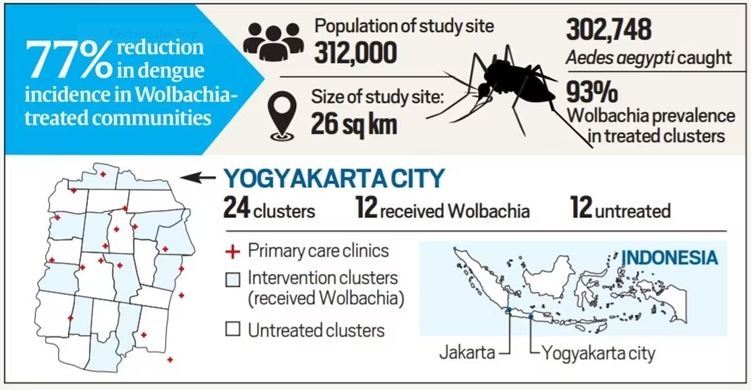ForumIAS announcing GS Foundation Program for UPSC CSE 2025-26 from 27th May. Click Here for more information.
Source– This post “Wolbachia Method” is based on the article “How mosquitoes stopped mosquitoes from spreading dengue in an Indonesian city” published in “The Indian Express” on 29 August 2020.
Why in News?
Researchers in Indonesia have found a way to fight disease-bearing mosquitoes, by breeding a species of mosquito which carries a certain kind of bacteria that prevents viruses like dengue from growing inside them.
What is Wolbachia?
(1) Wolbachia is a common bacteria that occurs naturally in 60% of insect species, including some mosquitoes, fruit flies, moths, dragonflies and butterflies.
(2) Wolbachia is usually not found in the Andes aegypti mosquito (the primary species responsible for transmitting human viruses such as Zika, dengue, chikungunya and yellow fever).
(3) Wolbachia is safe for humans, animals and the environment.
What is Wolbachia Method? And how it works?
(1) Bacteria Introduction– In the Wolbachia method, Aedes aegypti mosquitoes are introduced with the bacterium in the lab and then researchers release them into the wild.
(2) Population Replacement Strategy- Now, the Wolbachia-infected mosquitoes breed with their wild counterparts which result in a growing percentage of the bacterium in those mosquitoes.
(3) This makes it harder for viruses to reproduce inside the mosquitoes. And the mosquitoes are much less likely to spread viruses from person to person.

What are the results of the Study?
(1) Dengue reduction-They found that using the Wolbachia method reduced the occurrence of dengue in the treated population by 77%.
(2) However Researchers have not understood why the Wolbachia bacterium interferes with the transmission of dengue. One theory is that the bacterium prevents dengue viruses from replicating in mosquito cells.
UPSC Syllabus- Science & Technology(Health)




